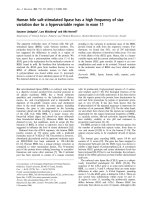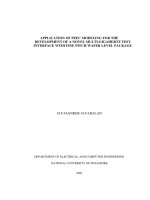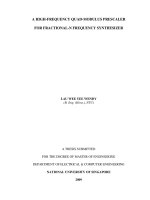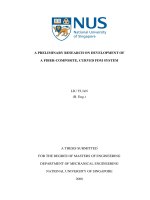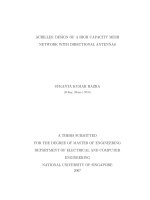Development of a high frequency ambient noise data acquisition system
Bạn đang xem bản rút gọn của tài liệu. Xem và tải ngay bản đầy đủ của tài liệu tại đây (11.3 MB, 125 trang )
DEVELOPMENT OF A HIGH FREQUENCY AMBIENT
NOISE DATA ACQUISITION SYSTEM
KOAY TEONG BENG
NATIONAL UNIVERSITY OF SINGAPORE
2004
DEVELOPMENT OF A HIGH FREQUENCY AMBIENT
NOISE DATA ACQUISITION SYSTEM
KOAY TEONG BENG
(B.Eng.(Hons.) UTM)
A THESIS SUBMITTED
FOR THE DEGREE OF MASTER OF ENGINEERING
DEPARTMENT OF ELECTRICAL AND COMPUTER
ENGINEERING
NATIONAL UNIVERSITY OF SINGAPORE
2004
Name:
Koay Teong Beng
Degree:
M. Eng.
Department: Electrical and Computer Engineering
Thesis Title: Development of a high frequency ambient noise data
acquisition system
ABSTRACT
High frequency ambient noise has a significant impact on the operation
of many Sonars and related systems. Therefore, understanding the temporal
and spatial distributions of this noise in shallow water is crucial. Existing highbandwidth acoustic data acquisition systems are large and complex. This
project has developed a novel stand-alone, portable, and compact cylindrical
package (23cm ∅ by 60cm length) that can be rapidly and flexibly deployed in
various configurations. It has 4 simultaneous sampling analog channels (up to
5MSa/s aggregate) and is capable of beamforming in 3D space using a
tetrahedral array configuration. This system has provided both time-space
distributions and directivity of high frequency ambient noise in Singapore
waters for the first time.
Keywords: High Frequency, Ambient Noise, Snapping Shrimp, Acoustic,
TDOA, Shallow Water, Spatial and Temporal Distribution
i
ACKNOWLEDGEMENTS
I would like to acknowledge the Acoustic Research Laboratory of the
Tropical Marine Science Institute for their support throughout the project,
especially A/Prof John Potter for his continuous guidance and patience over
the years. Also, this project would not be possible without the dive team
support, they are: Mr. Eric Delory, Mr. Sorin Badiu, Mrs. Caroline Durville, Mr.
Mandar Chitre, Dr. Matthias Hoffmann-Kuhnt, and A/Prof John Potter.
In addition, I would also like to conduct my appreciation to Dr
Venugopalan Pallayil and Mr. Mohanan Panayamadam for the administrative
and field trip support, Mr Mandar Chitre and Dr. Matthias Hoffmann-Kuhnt for
proof reading the thesis.
This work has been supported by the Singapore DSTA Research
Directorate.
ii
TABLE OF CONTENTS
Abstract ............................................................................................................ i
Acknowledgements ..........................................................................................ii
Table of Contents ............................................................................................iii
Summary ......................................................................................................... v
List of Tables ..................................................................................................vii
List of Figures ................................................................................................ viii
Chapter 1 Introduction ..................................................................................... 1
1.1 Background............................................................................................ 2
Chapter 2 System Design................................................................................ 6
2.1 Embedded Pentium PC.......................................................................... 8
2.2 Operating System: Embedded NT ....................................................... 10
2.2.1 Compiling a Customized Embedded NT........................................ 11
2.3 Remote Administration of the Data Acquisition .................................... 12
2.4 PCI Data Acquisition Card ................................................................... 14
2.5 High-Speed Data Storage .................................................................... 16
2.6 Power Supply Modules ........................................................................ 18
2.7 Analog Front-End for High Impedance Hydrophones .......................... 20
2.7.1 Hydrophone and its High Impedance Piezoelectric Noise Model .. 21
2.7.2 High Impedance Analog Front-End ............................................... 24
2.7.3 Analog Stage with Pre-selectable Gain ......................................... 26
2.7.4 High Pass and Anti-aliasing Filter.................................................. 28
2.7.5 Printed Circuit Board Design ......................................................... 32
2.8 Prototype Electronics Performance...................................................... 34
2.8.1 The Noise of the Analog Board ..................................................... 34
2.8.2 Analog Channel Transfer Function ................................................ 36
2.9 Heading and Pan-and-tilt Sensor ......................................................... 38
2.9.1 Basics of a Tilt Compensated Electronic Compass ....................... 38
2.9.2 Compensating the Earth’s Magnetic Field Distortion Due to Nearby
Ferrous Material and Internal Offsets ..................................................... 41
2.10 Hydrophone Array .............................................................................. 45
iii
2.10.1 Determining the Array Size.......................................................... 45
2.10.2 Acoustically Transparent Mounting Frame .................................. 47
2.11 Electronics Housing and Supporting Structure................................... 49
3.11.1 Electronics Housing..................................................................... 49
3.11.2 Supporting Structure.................................................................... 52
Chapter 3 Labview Acquisition Software ....................................................... 55
Chapter 4 Beamforming Algorithm ................................................................ 58
4.1 Time Difference of Arrival (TDOA) Beamforming ................................. 58
Chapter 5 Experiment Setup ......................................................................... 62
5.1 Mapping Noise Sources at the Seabed................................................ 64
5.2 Source Level Estimation Tolerance ..................................................... 65
5.3 Simulation ............................................................................................ 67
Chapter 6 Field Experiments ......................................................................... 69
Chapter 7 Results.......................................................................................... 73
7.1 Power Distribution Function of Local Ambient Noise ........................... 74
7.2 High Frequency Ambient Noise Directivity ........................................... 77
7.3 Spatial Distribution of Snap Sources.................................................... 78
7.4 Snapping Shrimp Source Level Estimation .......................................... 83
7.5 Temporal Variation of Snapping Shrimp Clicks.................................... 88
Chapter 8 Conclusion .................................................................................... 91
8.1 Future Work and System Upgrades ..................................................... 92
References .................................................................................................... 94
Appendices.................................................................................................... 97
iv
SUMMARY
It is known that high frequency ambient noise level is significantly
higher in warm shallow water compared to deep-water ambient noise, which
would affect the operations of various underwater equipments. Researchers
have found that snapping shrimp noise is the dominant component (around
190dB re 1uPa @ 1m peak to peak) within frequency range from 2kHz to
more than 300kHz) in such regions. At the time of this project, there are very
few studies of high frequency ambient noise directivity and its source
distribution, and none in Singapore. The project aims to fill this research gap.
At the initial stage, a set of remotely controlled (client server based),
seabed mounted, directional receivers were developed. When working
together, they are capable of mapping the snapping shrimp acoustic sources
on the seabed using a stochastic tomography inversion algorithm. As the
project evolved, a much more portable, compact and flexible quad channel
acoustic array, named High frequency ambient noise Data AcQuisition
System (HiDAQ), was developed. It enabled local researchers to rapidly study
the ambient noise in waters that are geographically confined. To the best of
our knowledge, this is the first system in the world with such mapping
capability that supports sampling rates of up to 5MSa/s.
This thesis focuses on the description of the HiDAQ, its development,
principle of operation, field trials and results. The system was designed based
on industrial technologies and embedded systems. A prototype electronic
compass based on a magneto-resistive sensor has also been built; its theory
of operation is also discussed. A Time Difference Of Arrival (TDOA) based
beamforming algorithm was developed and used in the field experiments.
Data obtained from field trials in the Southern Islands in Singapore are
presented in this thesis. This project has collected directivity measurements of
local ambient noise and spatial and temporal distributions of local ambient
noise source levels in Singapore for the first time.
v
Two conference papers (student as principle author) have been
presented in OCEANS conferences in the year 2002 and 2003 on the system
and the snapping shrimp acoustic distribution study. Another two other
conference papers related to the usage of HiDAQ (research student as coauthor) have been presented in year 2003.
vi
LIST OF TABLES
Table 1:
Comparisons of performance between some industrial PCs ......... 9
Table 2:
Selections of input voltage ranges for analog input channels ...... 15
Table 3:
Optimum acquisition parameters of current hardware configuration
..................................................................................................... 17
Table 4:
The maximum power consumption of the sub modules............... 19
Table 5:
Simplified hydrophone specification............................................. 21
Table 6:
Measured gain of each channel at different setting ..................... 38
Table 7:
Compass heading calculations .................................................... 40
vii
LIST OF FIGURES
Figure 1:
Partial setup of the bottom mounted (left) and surface mounted
(right) configuration ....................................................................... 5
Figure 2:
Block diagram of HiDAQ hardware ................................................ 6
Figure 3:
Electronic modules packaged in a compact mounting cage. ......... 7
Figure 4:
HiDAQ electronics package ready to be deployed ........................ 8
Figure 5:
Industrial embedded PC based on Pentium MMX technology in
PC104+ form factor..................................................................... 10
Figure 6:
Embedded NT target designer software ...................................... 11
Figure 7:
Fifty meter long underwater cable consisting a filtered power line
and an Ethernet link .................................................................... 13
Figure 8:
Different ways of controlling the HiDAQ....................................... 14
Figure 9:
Data acquisition card, PC104+ to slot PC converter and SCSI160
host bus adapter ......................................................................... 18
Figure 10: Power supply and battery............................................................ 19
Figure 11: High performance hydrophone in protective cover...................... 22
Figure 12: Noise equivalent circuit of a Piezoelectric Sensor (from low-noise
electronic system design by Motchenbacher & Connelly [22]) .... 22
Figure 13: High Impedance Voltage Follower with DC Servo and Integrated
High Pass Filter........................................................................... 25
Figure 14: Low Noise Selectable Gain Stage............................................... 27
Figure 15: Schematic of High Pass Filter ..................................................... 29
Figure 16: 8th Order Low Pass Filter (LPF) ................................................. 31
Figure 17: Frequency Response and Group Delay for the low pass filter .... 32
Figure 18: Current return path of different of various analog stages ............ 33
Figure 19: PCB for the analog signal conditioning ....................................... 34
Figure 20: Typical frequency response curve of the analog board............... 37
Figure 21: Magnetic field of the Earth (adapted from application note by
Caruso, Honneywell)................................................................... 39
Figure 22: Ideal X-Y reading of the Earth’s horizontal magnetic field........... 40
Figure 23: Compass orientation ................................................................... 41
Figure 24: 360° Magnetic reading of prototype compass: ferrous interfered
(top) and soft/hard iron compensated (bottom). ......................... 42
viii
Figure 25: Area of interest and the distance between hydrophones. ........... 46
Figure 26: Tetrahedral frame for the three-dimensional hydrophone array .. 49
Figure 27: Underwater electronics housing (adapted from specification
drawing, Prevco Inc.) .................................................................. 50
Figure 28: Mechanical drawing of the internal electronics cage and
assembled electronics package .................................................. 51
Figure 29: Mechanical drawing of the new underwater housing .................. 52
Figure 30: Mechanical drawing of the 4m tall stainless steel tripod. ............ 54
Figure 31: Diagram view of the acquisition software. ................................... 55
Figure 32: The Graphic User Interface for the acquisition software. ............ 57
Figure 33: Geometry of the tetrahedral array ............................................... 59
Figure 34: HiDAQ in surface mounted configuration. ................................... 63
Figure 35: HiDAQ in bottom-mounted configuration..................................... 64
Figure 36: Range estimation errors due to snapping position and seabed
variation ...................................................................................... 66
Figure 37: Range estimation error over source distance from tripod ........... 67
Figure 38: Inverted source map from a simulated distribution...................... 68
Figure 39: Deployment of HiDAQ using a tubular spar-buoy ....................... 70
Figure 40: Deployment of HiDAQ in bottom-mounted configuration from a
barge........................................................................................... 71
Figure 41: The remote control station: a simple laptop with Ethernet
connection................................................................................... 72
Figure 42: Power distribution density of time series over 20 seconds.......... 76
Figure 43: Directivity plots (in dB) of high frequency ambient noise............. 78
Figure 44: Spatial distribution of snap occurrences at Selat Pauh ............... 81
Figure 45: Spatial distribution of snap occurrences at Raffles Reserve site A
82
Figure 46: Source level PDF shows median snap power around 172~176 dB
re 1 µPa at 1m from bottom and 163~173 dB re 1 µPa at 1m from
surface. The red curves are normal fit to the distribution. ........... 84
Figure 47: Spatial distribution of mean peak-to-peak source level over 20
minutes ....................................................................................... 86
Figure 48: The relationship between high frequency ambient noise directivity
at both sites and the nearby snapping shrimp sources. .............. 87
ix
Figure 49: Sample plots of source level at Raffles Reserve sites. ............... 89
Figure 50: variations of mean of source level over time. .............................. 90
x
CHAPTER 1
INTRODUCTION
Many marine related scientific survey systems use acoustics. After the
end of the cold war era, marine communities and researchers started to
diversify resources from deep-water operations to study acoustics in shallow
waters. Recent worldwide terrorist threats have also generated a lot of interest
in homeland security for many countries, which has led to increased
operations in their local waters. These operations include defending the
coastlines against small and yet potentially hostile subjects and water column
monitoring in shallow waters. Since shallow waters do not support the use of
low frequency acoustics efficiently, high frequency acoustics has been
extensively used for its operational feasibility. High frequency sonar is capable
of interrogating subjects and the environment in a smaller geometry, which
suits the nature of the shallow water environment where objects of interest are
generally smaller. Nevertheless, ambient noise in warm shallow waters level
is alarmingly stronger (more than 25 dB higher) compared to the deepwater
ambient noise [1] and significantly affects the operations of these sonar
systems. Therefore, it is crucial to understand the structure of the high
frequency ambient noise in order to effectively operate these systems.
Being an island country and one of the busiest ports in the world,
Singapore needs to effectively manage its surrounding marine resources,
maintain security in its local waters for commercial shipping, protect its high
value assets around the coastlines etc. For these reasons, Singapore is
continuously monitoring, exploring and studying the marine environment.
These efforts involve an extensive use of high frequency oceanographic
equipment in local waters. High frequency ambient noise in Singapore waters
is dominated by snapping shrimp (genera Alpheus, Synalpheus & Penaeus)
[2], hence studying the acoustics of these creatures will give us a good
understanding of local ambient noise at high frequencies. Although there are
many ambient noise studies, there are very few attempts to map the ambient
noise sources and no such experiment has been conducted in Singapore
waters prior to this project.
1
Work done in this thesis is aimed at studying the spatial and temporal
distribution of ambient noise source in shallow waters [3] and to produce
some maps of noise source distribution in Singapore waters for the first time.
The results generated from this work support various experiments carried out
by the Acoustic Research Laboratory at the Tropical Marine Science Institute.
This project involved the development of a robust, portable and easy-todeploy instrument for the purpose of this study in particular and for the
purpose of studying high frequency transients in 3-dimensional space in
general. The equipment developed has proved very useful and has
contributed to various scientific underwater studies at the laboratory that have
involved high frequency acoustics such as bio-sonar, shrimp noise directivity
[4], humpback whale acoustics [5] and, recently, living resource classification
replacing the system used in the initial attempts [6].
1.1 Background
Acoustics is one of the best and most efficient tools to investigate the
aquatic environment. High-frequency Electro-Magnetic (EM) waves do not
travel far in seawater due to attenuation (about 18dB attenuation per meter at
180kHz in seawater), limiting its to short range operations or the usage of very
low frequency range (hence a large antenna) for long range operations [7].
These factors make it an unattractive choice to be used underwater. Laser
systems have been used in various areas for short-range applications, where
the operation ranges are highly dependent on the turbidity of the medium.
Acoustic energy, on the other hand, travels efficiently in seawater and is
widely used in modern underwater systems for various applications such as
geoacoustic studies, bathymetry studies, navigation, communication etc.
Snapping Shrimp produce high-energy broadband noise through the
collapse of cavitation bubbles [8]. They are known to dominate shallow water
ambient noise from 2kHz to over 300kHz [9], at peak-to-peak source levels of
190dB re 1 uPa @ 1m [10]. These transients could present severe
interference to many sonars and need to be suppressed with various transient
suppression techniques. On the other hand, ambient noise can also be used
as a tool for imaging and the Acoustic Research Laboratory of the Tropical
2
Marine Science Institute at the National University of Singapore has
developed a next generation sonar system, named ROMANIS, that uses
these signals to create an acoustic image of the environment [11].
Therefore, understanding the temporal and spatial distributions of high
frequency ambient noise sources is one of the key factors for sonar operators
to efficiently operate a high frequency system. These problems have lead to a
number of ambient noise studies in shallow waters, some examples are [9]
[12] [13] [14]. Nevertheless, there are limited studies in Singapore.
Acoustic Research Laboratory has conducted a series of ambient noise
studies in Singapore waters using an omni-directional acoustic recording
system [9]. The results revealed that the probability distribution function of the
ambient noise power exhibits an approximately lognormal distribution. This
suggested that the ambient noise sources seem to cluster either in time or
space, or possibly both [15]. In order to explain the distribution, the spatial
and temporal distributions of these noise sources need to be mapped. There
were only a few such experiments in the world, which normally involved large
structures and arrays [16] [17]. Furthermore, these projects looked at
frequency ranges below 100kHz
The aim of this project is to produce the spatial and temporal
distributions of high-frequency underwater ambient noise sources for the first
time in Singapore waters. This project studied the ambient noise over a large
frequency range (from 1kHz up to 200kHz). A robust and portable
instrumentation was developed to estimate the angular distribution, range,
and source levels of transient sources in three-dimensional space. It is also
flexible enough to serve as a multi-purpose, multi-channel high frequency
data acquisition system. The directivity of local ambient noise was studied for
the first time
A single acoustic array that is compact, portable, and capable of being
deployed at open sea was desired. The system needs to estimate the
direction of arrival, range, and source levels of transient sources of local
ambient noise (dominated by snapping shrimp). This calls for acquisition
3
hardware with at least 4 acoustic channels, each acquiring signals up to
200kHz, to cover the majority frequency range of snapping shrimp noise.
Therefore, we needed a four-element spatial array to sample the acoustic
signals in three-dimensional space with at least 400kSa/s per channel to
avoid aliasing of the signals. All four channels had to be synchronized to allow
for beamforming. Furthermore, the data had to be streamed to storage
devices in real-time with a minimum continuous recording speed of 1.6MSa/s.
Commercially
available
data
acquisition
systems
with
such
specifications are based on desktop Personal Computers (PC), which are not
suitable for this application. Desktop systems are bulky, and not portable;
they also need an AC power supply. Most desktop PCs need air ventilation
and therefore can’t be sealed to work underwater; this also makes them
unsuitable to work in sea breezes due to the threat of corrosion to the
electronics. An embedded system that runs at low power had to be built to
address these issues.
The designed HiDAQ is capable of simultaneously sampling four
analog channels with aggregated sampling rates of up to 5MSa/s with 12-bit
resolution. The analog channels are connected to four hydrophones with 5meter long flexible cables, allowing it to be arranged in various array
configurations. The system stores the acquired data into a built-in high-speed
SCSI harddisk. The directivity of the sources and their distribution map is
obtained after post-processing.
In the post processing process, the system deterministically identified
high frequency transient in all four channels. Once they are identified, their
inter-channel time delay is determined and used to beamform the transient
direction. Although the array is sparse, the beamforming is possible because
the dominant ambient noise sources are broadband and impulsive in nature.
Figure 1 shows pictures of a partial setup: 1) surface mounted and 2) bottom
mounted configuration.
4
Figure 1:
Partial setup of the bottom mounted (left) and surface mounted (right)
configuration
5
CHAPTER 2
SYSTEM DESIGN
HiDAQ
was
designed
using
standard
industrial
form
factors,
interconnections and communication protocols in order to keep the cost low
and to allow for the use of a wide diversity of existing industrial electronic
modules.
HiDAQ
was
built
from
Commercial
Off-The-Shelf
(COTS)
technology with a customized analog front end and signal conditioning
circuitries. One of the challenges of the hardware system design was to run
the system on a low power CPU using a stripped down version of Embedded
Windows NT to conserve power and yet to provide enough CPU resources for
the acquisition task. This was done by integrating a COTS data acquisition
card and high-speed storage system on a low-power Pentium processor in
PC104+ format. The system could either be operated from battery power or
from AC power. It also provided a number of human interface modes with the
system OS and the acquisition software.
Dedicated Battery and Regulation for
Analog Circuitry
PC104+ PC Based Digital To analog Conversion And Data Acquisition
System
Hydrophone
Hydrophone
Optional
Mouse &
Keyboard
DE
EI
40MByte/s in a SCSI160
Highway (160MByte/s max)
Adaptec PCI to
SCSI160
Interface Card
Ethernet
Controller
2.5" IDE HD for
Operating
System
Ethernet Connection for
Remote Access
+5V
+12V & +5V
10,000 rpm
SCSI160 HD
Optional VGA
Display
Intel 266MHz
Tilamok
Embedded
System
PCI BUS
Hydrophone
Analog Front
End &
Signal
Conditioning
Hydrophone
VGA
Controller
National
Instrument
NI6110E-PCI
card
PC104 Power Supply Unit
232Watt-Hour Battery Pack
Figure 2:
Block diagram of HiDAQ hardware
An embedded CPU system based on the PC104+ form factor was
chosen because it provided numerous standard PC peripherals and
6
communication protocols. A converter board and adapters were used to
bridge the PC104+ interconnection formats to standard desktop PC
interconnection formats. A high speed Analog-to-Digital Converter (ADC) card
in standard PCI edge connection was used as the digitizer, and a PCI
SCSI160 adapter was used with a 80GB SCSI harddisk to provide high-speed
data storage. A standard 2.5” laptop IDE harddisk was used to store the
operating system, thus isolating the data storage harddisk from any delays
caused by OS-related accesses. An analog signal conditioning circuitry was
designed in-house to receive signals from the four hydrophones, to provide
amplification and filtering, and then to feed the signals to the ADC. The
system could be powered from one of two power supply options: the first is a
Li-Ion battery pack and the second is 230V AC power line through a modified
mini-ATX power supply. This made HiDAQ capable of running both as a
standalone system for short-term deployment and as a surface powered
system for long-term deployment. Figure 2 shows a block diagram of the
system. The sections in blue are parts that interconnect the internal
electronics to external devices; they include the hydrophones connections and
the communication links to the electronics. These parts were packed in a
compact mounting cage (see Figure 3), which was then mounted in a
cylindrical watertight housing.
Figure 3:
Electronic modules packaged in a compact mounting cage.
The complete electronics package, including watertight housing, is a
cylindrical package of less than 23cm in diameter by 60cm in length and
weighs about 25kg in air and about 5kg in water. Figure 4 is an illustration of
7
the electronics package in the housing with hydrophones and mounting
brackets attached.
Figure 4:
HiDAQ electronics package ready to be deployed
2.1 Embedded Pentium PC
Several Pentium-based embedded processors were evaluated for the
purpose of the project. Although high-performance embedded processors
(500MHz or higher) would have been desirable for the acquisition system, the
heat dissipation problem and the large power consumption made them
unsuitable for the project. A processor with moderate processing power was
used with a high-end data storage interface and an acquisition card with a
good buffer scheme to provide desirable performance. Furthermore, in order
to reduce the overhead to the CPU, the operating system was stripped down
to the minimum required. Table 1 shows a comparison on the power
consumptions and features of some of the embedded PCs considered.
8
Table 1:
Comparisons of performance between some industrial PCs
CPU
AMD SC520
Geode
Pentium
Tillamook
MMX
Pentium III
Format
PC104+
ETX
PC104+
EBX
Max Speed
133MHz
266MHz
266MHz
750MHz
RAM
64Mbyte
128Mbyte
128Mbyte
512Mbyte
Peripherals
Full PC
peripherals
Full PC
peripherals
Full PC
peripherals
Full PC
peripherals
Typical Power
consumption
4W
5W
8W
20~25W
VGA controller
No
Yes
Yes
Yes
Ethernet
controller
Yes
Yes
Yes
Yes
Processor
performance
Low
Medium
Upper
medium
High
The Central Processor Unit (CPU) chosen was an industrial embedded
PC in the PC104+ platform that was built around Intel’s Pentium Tillamook
266MHz MMX processor. This system was chosen for its low power
consumption, its compatibility to Windows NT, and its ability to provide a
complete range of PC peripherals. Furthermore, the system included a built-in
VGA controller and Ethernet controller with transceiver. It was installed with
128Mbyte of SODIMM SDRAM, providing enough memory space for the
acquisition application software and advanced buffering for the ADC
operations. The embedded PC was built around standard electronic
components used in desktop motherboards; therefore it was supported by the
widely available device drivers for standard operating systems. In addition, it
also guaranteed good inter-operatability with other standard industrial
modules. Figure 5 shows the PC104+ module used.
9
Figure 5:
Industrial embedded PC based on Pentium MMX technology in PC104+
form factor
2.2 Operating System: Embedded NT
Embedded Windows NT 4.0 with service pack 5 was used to run the
embedded PC. This operating system was chosen because it uses standard
NT drivers and hence has wide range of driver support. Embedded NT also
allowed us to select only the necessary parts of the operating system,
compiling them and deploying the customized operating system into the
embedded PC. This feature allowed us to exclude unnecessary OS
components, thus minimizing the CPU operations and hence increased the
system performance.
Additionally, Embedded NT allowed for self-logon during system bootup while still providing good security screening for remote access requests.
This allowed the system to boot up by itself during power up, to load and run
10
the necessary software including the graphical remote access server and to
provide password authentication to access the system afterwards.
2.2.1 Compiling a Customized Embedded NT
Figure 6 shows the target designer for creating Embedded NT
operating systems. Firstly, the developer selects and enables the desired
operating system components at the “All Nodes” pane. These selections
cover every aspect of the OS from general support such as hardware
abstraction for different CPU platforms, support for different types of
peripheral devices, and support for various management and networking to
specific driver support of devices from third-party companies.
All nodes pane
Component
selection
Figure 6:
Embedded NT target designer software
After all the necessary components are selected and configured, the
system is then compiled to generate an image of a working operating system
ready to be deployed to the embedded system.
For the HiDAQ, the boot up memory was a small 2.5” harddisk
containing the embedded NT operating system. The harddisk was prepared
11
by firstly formatting it with boot loader using a utility disk supplied with the
Embedded NT installation package. After that, the entire operating system
image was copied onto the harddisk. Alternatively, the harddisk can be first
installed with a normal Windows NT operating system, which the embedded
NT image will replace.
2.3 Remote Administration of the Data Acquisition
Three different control interfaces were provided by HiDAQ: the first was
through direct user interface by connecting a monitor, a mouse and a
keyboard to the system; the second was through graphical remote
administration via an Ethernet connection; and the third was through
prescheduled activities upon boot up for standalone operation. The first was
useful for software development, debugging and testing, especially when
working in the laboratory where the system was hooked up like a normal PC.
For the direct connection, an underwater cable with appropriate connectors
was designed to enable remote control at up to 10 meters away, which was
especially useful for deployments near the sea surface or in test tanks.
Operating in this mode provided a delay-free remote control; the only
drawback was that the display quality dropped over range. This could be fixed
by inserting a VGA signal booster circuitry in between, but is currently not
implemented.
The second method was using Microsoft Netmeeting’s Desktop
Sharing via TCP/IP running over an Ethernet connection. With this, the users
were able to logon into the Embedded NT, and to take control on its windows
desktop, providing accesses to any applications within HiDAQ. A 50m
underwater cable was designed for this purpose, allowing users to remotely
perform data acquisition and download the data from HiDAQ to a remote
system. The limitations of this method are the slow feedbacks from desktop
graphic, keystroke, and mouse activity, which are not crucial for control
purposes. This method was largely used in the experiment due to the
combination of its flexibility and distance. When the system was deployed with
this method, it was normally powered from the surface with 240V AC supply
provided through the same 50-meter cable. A junction box with a built in AC
12
noise filter and on/off switch was provided at the surface end of the cable.
Figure 7 shows a picture with the cable (1) to the HiDAQ casing, a standard
cross-over signal RJ45 Ethernet connector (2) and a standard AC power cord
(3).
Figure 7:
Fifty meter long underwater cable consisting a filtered power line and an
Ethernet link
When HiDAQ is setup for standalone operation, a precompiled user
acquisition program based on Labview®, a graphical programming language
promoted by National Instruments, was loaded into the startup folder in the
Embedded NT so that it would be automatically executed after it had been
booted up. Acquisitions were performed based on the preset schedules in the
program. The drawback of this method was that the users did not have
access to HiDAQ during runtime. Nevertheless, this operation mode was
necessary for standalone operation mode where no surface structure was
nearby to support a user control station and no cabling was possible.
13
